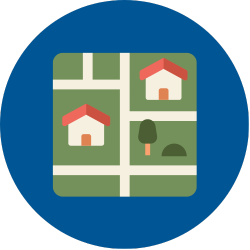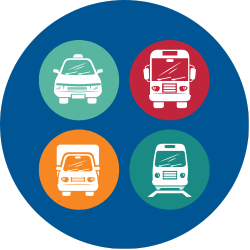The goal of a Comprehensive Plan Update is to add, edit, or remove goals, policies, strategies, and concepts based on new priorities, new state requirements, and public input.
In reviewing and updating the elements, County staff used the following resources:
- A Gap analysis that identified where revisions were needed in order to be consistent with Multicounty Policies (MPPs) in VISION 2050 and Countywide Planning Policies (CPP).
- The Department of Commerce Periodic Update Checklist to ensure consistency with the Growth Management Act and state requirements.
- Input received during public outreach meetings and input received from the County's internal working group comprised of various departments of the County and external service providers.
When reading each comprehensive plan element, you will see a series of goals, policies, and strategies. Goals and policies are aspirational in nature and reflect the vision and intent of the County. Strategies are more actionable and achievable in nature. Each goal will have its own set of policies and strategies.
Because this version of the plan is this chapter is a “repeal and replace” of the previous version, it cannot easily be directly compared. However, the summaries below describe some major themes or additions for each element.
Land Use
 The Land Use Element's intent is to direct the majority of growth toward urban areas, provide greater distinction between urban and rural areas, guide land use patterns to allow for the efficient provision of urban services such as sewers and transportation systems, preserve open space, recognize and preserve historical and archaeological resources, and ensure compatibility between adjacent zones. Major themes include: The Land Use Element's intent is to direct the majority of growth toward urban areas, provide greater distinction between urban and rural areas, guide land use patterns to allow for the efficient provision of urban services such as sewers and transportation systems, preserve open space, recognize and preserve historical and archaeological resources, and ensure compatibility between adjacent zones. Major themes include:
- Ensuring Urban Growth Areas are accessible by multi-modal transportation and include a mix of services, shopping, entertainment, recreation, educational facilities, and housing of different types and at different levels of affordability
- Protection of rural character by directing development to Urban Growth Areas
- Providing for small agricultural activities throughout the County
- Protection of mineral and timber resource lands
- Ensuring land use decisions have equitable impacts and outcomes
- Promotion of a built environment that enables healthy living
Economic Development
 The Economic Developement Element aims to encourage economic development in Kitsap County that considers the regional economic context and is suited to the unique conditions of the county. The element is designed to build capacity and guide the economic prosperity and resiliency of Kitsap County. The Economic Development goals, policies, and strategies provide the framework to improve and sustain Kitsap County's fiscal, economic, and social conditions utilizing local resources, partnerships, and economic opportunities. Major themes include: The Economic Developement Element aims to encourage economic development in Kitsap County that considers the regional economic context and is suited to the unique conditions of the county. The element is designed to build capacity and guide the economic prosperity and resiliency of Kitsap County. The Economic Development goals, policies, and strategies provide the framework to improve and sustain Kitsap County's fiscal, economic, and social conditions utilizing local resources, partnerships, and economic opportunities. Major themes include:
- Retention and recruitment of family-wage employers while leveraging the Navy's presence
- Encouragment of women-, and minority-owned small businesses and start-ups
- Exploration of emerging industries, technologies, and services that promote environmental sustainability
- Expansion of strategies to expand access to business and employment opportunity
- Expansion of strategies to address and prevent commercial displacement of small minority-owned businesses
Environment
 The purpose of the Environment Element is to provide the goals, direction, and path for the future of sustaining natural environments in Kitsap County. Kitsap County recognizes the importance of protecting the natural environment while providing for the needs of the growing number of residents and businesses that call this place home. Ecosystems such as forest lands, shorelines, freshwater systems, and other areas all make up the natural environment of Kitsap County. Human well-being depends on a healthy, natural environment to provide for clean air, clean water, food, and overall high quality of life. The quality and abundance of Kitsap County's natural environments are well documented and are what define Kitsap County as the "natural side of Puget Sound." Major themes include: The purpose of the Environment Element is to provide the goals, direction, and path for the future of sustaining natural environments in Kitsap County. Kitsap County recognizes the importance of protecting the natural environment while providing for the needs of the growing number of residents and businesses that call this place home. Ecosystems such as forest lands, shorelines, freshwater systems, and other areas all make up the natural environment of Kitsap County. Human well-being depends on a healthy, natural environment to provide for clean air, clean water, food, and overall high quality of life. The quality and abundance of Kitsap County's natural environments are well documented and are what define Kitsap County as the "natural side of Puget Sound." Major themes include:
- Treating Natural Resources as an Asset, and policies that define and promote the Kitsap Natural Resource Asset Management Program (KNRAMP)
- Emphasis on the importance of the ecosystem and critical areas throughout the County
- Ensuring environmental regulations are consistent with best available science
- Recognition of the health benefits of natural systems and aims to reduce adverse environmental impacts on vulnerable populations
- Enhancement of urban tree canopy and recognize the benefits of urban forests (replacement or retention)
Housing
 The Housing Element recognizes that housing is a fundamental need. The County is responsible for providing policy direction that facilitates housing for residents in all economic segments. The goals and policies of this element set the stage for development regulations that allow for and encourage different types of housing affordable to all population segments, avoid concentrating housing in environmentally sensitive areas, and guide intergovernmental coordination that makes the most efficient use of resources to provide housing, while reducing or eliminating housing barriers. Major themes include: The Housing Element recognizes that housing is a fundamental need. The County is responsible for providing policy direction that facilitates housing for residents in all economic segments. The goals and policies of this element set the stage for development regulations that allow for and encourage different types of housing affordable to all population segments, avoid concentrating housing in environmentally sensitive areas, and guide intergovernmental coordination that makes the most efficient use of resources to provide housing, while reducing or eliminating housing barriers. Major themes include:
- Ensuring sufficient housing stock is available, affordable, and accessible at all income levels and in a variety of housing types
- Encouragement of multi-family and missing-middle housing, specifically focusing on in existing urban centers
- Promotion of infill housing in Urban Growth Areas and preservation of existing affordable housing stock
- Mitigation of displacement risk and ensuring equitable treatment and outcomes
Transportation
 The Transportation Element presents a plan for transportation facilities and services needed to support the County's land use strategy over a 20-year planning horizon and recommends transportation projects for the County's unincorporated area to meet safety, capacity, and connectivity needs—for automobiles, freight, transit, bicyclists, and pedestrians. Major themes inlcude: The Transportation Element presents a plan for transportation facilities and services needed to support the County's land use strategy over a 20-year planning horizon and recommends transportation projects for the County's unincorporated area to meet safety, capacity, and connectivity needs—for automobiles, freight, transit, bicyclists, and pedestrians. Major themes inlcude:
-
A shift to Multi-modal transportation planning, emphasizing moving people rather than vehicles through support of high-capacity transit and other modes of transportation
-
Increased emphasis on public health, equity, safety, and climate change
-
Improved planning for active transportation (bicycles and pedestrians), including policies to support the development of new methodologies to analyze the level of service for multiple modes of transportation, not just cars
- Increased policy emphasis on multi-modal transportation support for mixed-use transit-oriented development and increased densities in Regional and Countywide Centers
- New policies to support the efforts to decarbonize the transportation system and reduce greenhouse gas emissions
- New policies to enhance the transportation system's resilience to a changing climate
- New policies to support an increase in electric vehicle infrastructure
Parks, Recreation and Open Space
 The Parks Element serves as a reference and foundation for future updates of the County's Parks, Recreation, and Open Space (PROS) Plan. It will identify opportunities for partnerships and funding and foster collaboration with stakeholders to ensure equitable access, environmental stewardship, and diverse recreational opportunities for the Kitsap community. The Parks Element serves as a reference and foundation for future updates of the County's Parks, Recreation, and Open Space (PROS) Plan. It will identify opportunities for partnerships and funding and foster collaboration with stakeholders to ensure equitable access, environmental stewardship, and diverse recreational opportunities for the Kitsap community. The goals and policies in this element recognize the need to enhance the wellbeing of all county residents and visitors through accessible and inclusive parks, facilities, and educational programs in promoting pedestrian use, bicycling, and accessibility through the provision of trails in the park system as well as the desire to institute management programs for habitat value, forest health, groundwater recharge, water quality, climate resiliency, and safety. Additionally, the goals and policies emphasize the need for coordination among agencies and organizations and the promotion of the many benefits of green infrastructure to support mental and physical health, recreational opportunities, habitat preservation, and stormwater management. Major themes include:
- Updates to existing inventories, and forecasts of future needs for active (fields, facilities) and passive recreation (trails and open space)
- Increased emphasis on support, enhancement, and use of green infrastructure
- Increased emphasis on preserving and enhancing tree canopy
- Explores new funding mechanisms to better support Parks development and maintenance
- Enhances the Park system's sustainability and resilience to a changing climate
- Increased emphasis on public health and equity
Capital Facilities and Utilities
 The Capital Facilities and Utilities Element provides policies for public facilities and services to serve the projected growth based on the County's adopted growth targets and future planned land use map. The Capital Facilities and Utilities Element provides policies for public facilities and services to serve the projected growth based on the County's adopted growth targets and future planned land use map.
The Element covers capital facilities and services provided by the County and external agencies, underscoring the need for coordination between and among municipalities, special purposed districts, and other providers.
The Element also guides planning, funding, and project decisions for unincorporated Kitsap County. With rapid population growth in the county, guidance to plan for sufficient capital facilities and utilities is crucial. The goals, policies, and strategies within this element direct the County and utility providers to stay updated on facility levels and demands to meet specific level of service standards and forecasted future needs for public facilities laid out in the Capital Facilities Plan. Major themes include:
-
Updates to existing inventories, and forecasts of future facility needs (pipes, pavement and facilities)
- Ensuring capacity and funding source for future facilities and utilities
- Increased emphasis on public health and equity
- Increased emphasis on support, enhancement, and use of green infrastructure
- Acknowledgement of Park lands as natural assets to be preserved, restored, and enhanced
Climate Change
 Climate Change is the only element in the 2024 Update that is brand new. Climate Change was added as a goal of the Growth Management Act during the 2023 legislative session, bringing the total number of goals to 15.
Climate Change is the only element in the 2024 Update that is brand new. Climate Change was added as a goal of the Growth Management Act during the 2023 legislative session, bringing the total number of goals to 15. Climate change has already affected and will continue to affect the infrastructure, natural systems, economy, culture, safety, and livelihood of people who live, work, and play in Kitsap County. Kitsap County has experienced measurable and observable climate change trends and impacts including extreme heat, coastal flooding, and wildfire smoke. The intent of this chapter is to provide a consolidated policy framework related to climate issues that is essential to facilitating planning for our county and to assist in meeting the planning goals of the Growth Management Act. Major themes include:
- Emphasis on reduction of Greenhouse Gas Emissions, based on a 2022 Community Wide Geographic Greenhouse Gas Emissions Inventory and Analysis
- Adoption of PSRC's VISION 2050 goal to reduce greenhouse gas emissions in the Puget Sound Region to 80% below 1990 levels by the year 2050
- Climate Resilience and Adaption Sub-Chapter, focused on various areas impacted by Climate Change, such as Public Health, Economy, Infrastructure, and Emergency Preparedness and Response
- Establishes a foundation for meeting new State climate planning legislation (required by 2029)
Sub Area, Neighborhood, and Regional Center Plans

Sub-Area Plans provide geographic-specific goals, policies and strategies for a community that compliment the overall plan.
|

